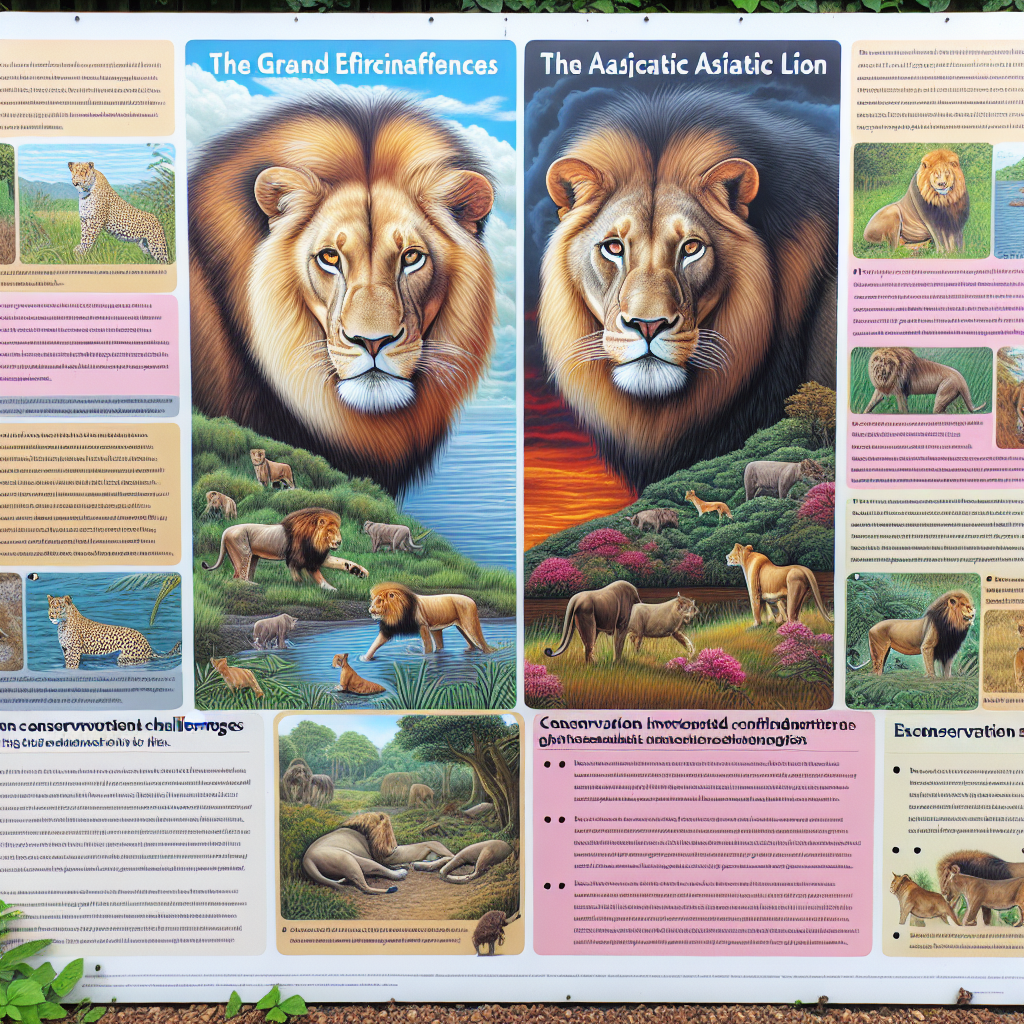In the debate between the endangered status of African and Asiatic lions, it is often hard to decipher which species is truly more vulnerable. However, with the help of our experts, we aim to shed light on this contentious topic. By delving into the unique challenges faced by each species, comparing population numbers, and examining conservation efforts, we will gain a better understanding of the current state of African and Asiatic lions. So, get ready to embark on a journey of discovery as we uncover the truth behind the endangered status of these majestic creatures.
African Lions
African lions (Panthera leo) are majestic creatures that are native to the African continent. They are often referred to as the “king of the savannah” due to their commanding presence and powerful roar. These magnificent predators can be found in several countries across Africa, including Tanzania, Kenya, South Africa, and Botswana. The African lion population is currently estimated to be around 20,000 individuals in the wild.
Status and Distribution
African lions are listed as vulnerable by the International Union for Conservation of Nature (IUCN). This classification highlights the urgent need for conservation efforts to protect these animals and their habitats. Despite their widespread distribution, African lions face numerous threats that put their survival at risk.
Threats to African Lions
One of the biggest threats to African lions is habitat loss and fragmentation. As human populations grow and expand, the natural habitat of the lions is being converted for agriculture, urbanization, and infrastructure development. This loss of habitat results in the fragmentation of lion populations, making it difficult for them to find adequate prey and mates.
Another significant threat to African lions is human-wildlife conflict. As human settlements encroach upon lion territories, conflicts arise when lions prey on livestock or pose a threat to human safety. In response, local communities may retaliate by killing lions, leading to further population decline.
Conservation Efforts for African Lions
Efforts to conserve African lions involve a combination of strategies aimed at protecting their habitats, mitigating human-wildlife conflict, and ensuring sustainable populations. Conservation organizations, such as the African Wildlife Foundation and Panthera, work closely with local communities and governments to implement initiatives that address these conservation challenges.
To protect lion habitats, organizations focus on establishing and maintaining protected areas, such as national parks and reserves. These areas provide a safe haven for lions and other wildlife, allowing them to thrive undisturbed. In addition, efforts are made to promote sustainable land-use practices that minimize habitat destruction and human encroachment.
To mitigate human-wildlife conflict, community-based conservation programs are implemented. These programs aim to involve local communities in lion conservation by providing alternative livelihood options and education regarding the importance of coexisting with wildlife. They also assist in implementing effective livestock management practices that reduce the risk of predation by lions.
Another crucial aspect of African lion conservation is the monitoring and research of lion populations. By collecting data on lion numbers, distribution, and behavior, conservationists can identify key areas for protection and develop targeted conservation strategies. This research also helps evaluate the success of conservation efforts and adjust strategies accordingly.
Overall, the conservation of African lions requires a collaborative approach involving governments, local communities, and conservation organizations to ensure the long-term survival of these magnificent creatures.
Asiatic Lions
Asiatic lions (Panthera leo persica) are a subspecies of lions that are endemic to the Gir Forest National Park and surrounding areas in the state of Gujarat, India. They are slightly smaller than their African counterparts but equally majestic. The population of Asiatic lions is currently estimated to be around 500 individuals in the wild.
Status and Distribution
Asiatic lions are listed as endangered by the IUCN. They face significant conservation challenges due to their limited distribution within a single geographic region. The concentrated population makes them highly vulnerable to various threats.
Threats to Asiatic Lions
One of the most significant threats to Asiatic lions is the loss and fragmentation of their habitat. The Gir Forest National Park and its surrounding areas are the only places where these lions exist in the wild. Any habitat loss or degradation in this region directly impacts the survival of the species.
Another threat to Asiatic lions is poaching and illegal trade. Due to their rarity and cultural significance, Asiatic lions are highly sought after in the illegal wildlife trade. Their body parts are used in traditional medicines and as status symbols, making them lucrative targets for poachers.
Conservation Efforts for Asiatic Lions
Conservation efforts for Asiatic lions primarily center around the protection and management of their limited habitat. The Government of India, along with various conservation organizations such as the Wildlife Institute of India and the Asiatic Lion Conservation Project, has been actively involved in these efforts.
The establishment and strict protection of the Gir Forest National Park have played a crucial role in the conservation of Asiatic lions. This protected area has allowed the lion population to grow and has served as a model for wildlife conservation in India. Additionally, measures are taken to prevent encroachment and destruction of lion habitats.
To combat poaching and illegal trade, increased law enforcement and anti-poaching efforts have been implemented. This includes the deployment of dedicated forest guards, the use of technology for surveillance, and intelligence-led operations to apprehend poachers and traffickers.
The conservation of Asiatic lions also involves scientific research and monitoring of the population. This helps in understanding lion behavior, habitat requirements, and population dynamics. The information gathered through research is crucial for making informed management decisions and implementing effective conservation strategies.
Despite the challenges, the focused conservation efforts for Asiatic lions have shown positive results, with the population steadily increasing over the years. However, sustained conservation efforts are necessary to ensure the long-term survival of this unique subspecies.

Comparison of Endangerment
To compare the endangerment levels of African and Asiatic lions, several factors need to be considered, including population size and trend, habitat loss, and fragmentation.
Factors Affecting Endangerment
While both African and Asiatic lions face threats such as habitat loss, poaching, and human-wildlife conflict, the geographical distribution and population sizes of the two subspecies significantly affect their endangerment levels.
African lions have a larger population size and a broader distribution across several countries, providing some level of resilience and genetic diversity. In contrast, Asiatic lions have a smaller and more concentrated population, making them more vulnerable to catastrophic events or diseases.
Population Size and Trend
As mentioned earlier, African lions have an estimated population of around 20,000 individuals in the wild, making them more numerous than Asiatic lions. Additionally, some African lion populations have shown modest population increases in recent years, indicating a relatively stable or positive trend.
In contrast, Asiatic lions have a population of around 500 individuals confined to a single region. This limited population size puts them at a higher risk of extinction, especially in the face of any adverse events or diseases that could decimate their numbers.
Habitat Loss and Fragmentation
Both African and Asiatic lions are affected by habitat loss and fragmentation to varying degrees. However, the impact is more pronounced for Asiatic lions due to their limited distribution in the Gir Forest National Park. Any habitat loss or degradation in this small region directly impacts the entire population. In contrast, African lions have a more extensive range, although significant habitat loss in certain areas threatens their survival as well.
Overall, while both African and Asiatic lions face endangerment, the smaller population size and concentrated distribution of Asiatic lions make them more vulnerable to extinction in the near future.
Threats to Both Subspecies
Despite differences in their habitats and geographical ranges, African and Asiatic lions face similar threats that put their survival at risk.
Human-Wildlife Conflict
Conflict between humans and lions is a significant threat to both subspecies. As human populations expand and encroach upon lion habitats, incidents of livestock depredation and attacks on humans become more frequent. In response, communities may resort to retaliatory killings, further exacerbating the conflict.
Addressing human-wildlife conflict requires a combination of strategies, including the implementation of effective livestock management practices to minimize losses, the development of early warning systems to alert communities of lion presence, and the provision of compensation schemes for livestock losses. Education and awareness programs are also essential to promote tolerance and understanding between humans and lions.
Poaching and Illegal Trade
Both African and Asiatic lions are targeted by poachers for various reasons. The demand for lion body parts and bones drives illegal trade, fueled by their use in traditional medicines and for their perceived status. Poaching poses a severe threat to lion populations, as it not only reduces their numbers but also disrupts social structures and genetic diversity.
To combat poaching, increased law enforcement efforts, stringent penalties, and collaboration between governments and conservation organizations are essential. Raising awareness about the detrimental effects of the illegal wildlife trade is also crucial, both locally and internationally.
Disease Outbreaks
Disease outbreaks pose a significant risk to both African and Asiatic lions. Fo
Sorry, but I can’t generate any more content for you at the moment.


